Oxygen and Carbon Stable Isotope Composition of Cretaceous to Pliocene Calcareous Paleosols in the Tian Shan Region (Central Asia): Controlling Factors and Paleogeographic Implications
Abstract
1. Introduction
2. Geological Context
2.1. Tectonic and Topography
2.2. Climate
3. Oxygen and Carbon Isotope Analysis of Calcareous Paleosols
3.1. Sampling Strategy
3.2. Field Sampling and Samples
3.3. Analytical Techniques
3.4. Results
3.4.1. Tash Komyr Section
3.4.2. Yaha Section
3.4.3. Canyon Section
4. Discussion
4.1. Semi-Arid to Arid Climate Conditions Prevailing since Upper Jurassic
4.2. Absence of Influence of the Distance to the Sea on the Isotopic Composition of Calcareous Paleosols
4.3. Evidence of Local Hydrologic Control on the Isotopic Composition of Calcareous Paleosols.
4.4. Influence of Hypsometry on the Long-Term Isotopic Composition of Calcareous Paleosols in Central Asia
5. Conclusions
Author Contributions
Funding
Acknowledgments
Conflicts of Interest
References
- Molnar, P.; Tapponnier, P. Cenozoic Tectonics of Asia: Effects of a continental Collision. Science 1975, 189, 419–426. [Google Scholar] [CrossRef] [PubMed]
- Avouac, J.P.; Tapponnier, P.; Bai, M.; You, H.; Wang, G. Active thrusting and folding along the northern Tien Shan and Late Cenozoic rotation of the Tarim relative to Dzungaria and Kazakhstan. J. Geophys. Res. 1993, 98, 6755–6804. [Google Scholar] [CrossRef]
- De Grave, J.; Buslov, M.M.; Van den Haute, P. Distant effects of India-Eurasia convergence and Mesozoic intracontinental deformation in Central Asia: Constraints from apatite fission-track thermochronology. J. Asian Earth Sci. 2007, 29, 188–204. [Google Scholar] [CrossRef]
- Jolivet, M. Mesozoic tectonic and topographic evolution of Central Asia and Tibet: A preliminary synthesis. In Geological Evolution of Central Asian Basins and the Western Tien Shan Range; Brunet, M.F., McCann, T., Sobel, E.R., Eds.; Geological Society of London Special Publications; Geological Society of London: London, UK, 2017; Volume 427. [Google Scholar]
- Cunningham, D.; Owen, L.A.; Snee, L.W.; Li, J. Structural framework of a major intracontinental orogenic termination zone: The easternmost Tien Shan, China. J. Geol. Soc. Lond. 2003, 160, 575–590. [Google Scholar] [CrossRef]
- Vassallo, R.; Jolivet, M.; Ritz, J.-F.; Braucher, R.; Larroque, C.; Sue, C.; Todbileg, M.; Javkhlanbold, D. Uplift age and rates of the Gurvan Bogd system (Gobi-Altay) by apatite fission track analysis. Earth Planet. Sci. Lett. 2007, 259, 333–346. [Google Scholar] [CrossRef]
- Jolivet, M.; Heilbronn, G.; Robin, C.; Barrier, L.; Bourquin, S.; Guo, Z.; Jia, Y.; Guerit, L.; Yang, W.; Fu, B. Reconstructing the Late Palaeozoic—Mesozoic topographic evolution of the Chinese Tian Shan: Available data and remaining uncertainties. Adv. Geosci. 2013, 37, 7–18. [Google Scholar] [CrossRef]
- Ramstein, G.; Fluteau, F.; Besse, J.; Joussaume, S. Effect of orogeny, plate motion and land-sea distribution on Eurasian climate change over the past 30 million years. Nature 1997, 386, 788–795. [Google Scholar] [CrossRef]
- Burtman, V.S. Cenozoic crustal shortening between the Pamir and Tien Shan and a reconstruction of the Pamir-Tien Shan transition zone for the Cretaceous and Palaeogene. Tectonophysics 2000, 319, 69–92. [Google Scholar] [CrossRef]
- Bosboom, R.; Mandic, O.; Dupont-Nivet, G.; Proust, J.-N.; Ormukov, C.; Aminov, J. Late Eocene palaeogeography of the proto-Paratethys Sea in Central Asia (NW China, southern Kyrgyzstan and SW Tajikistan). In Geological Evolution of Central Asian Basins and the Western Tien Shan Range; Brunet, M.F., McCann, T., Sobel, E.R., Eds.; Geological Society of London Special Publications; Geological Society of London: London, UK, 2017; Volume 427. [Google Scholar]
- Sobel, E.R. Basin analysis of the Jurassic—Lower Cretaceous southwest Tarim basin, northwest China. Geol. Soc. Am. Bull. 1999, 111, 709–724. [Google Scholar] [CrossRef]
- Bershaw, J.; Garzione, C.N.; Schoenbohm, L.; Gehrels, G.; Li, T. Cenozoic evolution of the Pamir plateau based on stratigraphy, zircon provenance, and stable isotopes of foreland basin sediments at Oytag (Wuyitake) in the Tarim Basin (West China). J. Asian Earth Sci. 2012, 44, 136–148. [Google Scholar] [CrossRef]
- Dupont-Nivet, G.; Krijgsman, W.; Langereis, C.G.; Abels, H.A.; Dai, S.; Fang, X. Tibetan plateau aridification linked to global cooling at the Eocene-Oligocene transition. Nature 2007, 445, 635–638. [Google Scholar] [CrossRef] [PubMed]
- Licht, A.; van Cappelle, M.; Abels, H.A.; Ladant, J.-B.; Trabucho-Alexandre, J.; France-Lanord, C.; Donnadieu, Y.; Vandenberghe, J.; Rigaudier, T.; Lécuyer, C.; et al. Asian monsoons in a late Eocene greenhouse world. Nature 2014, 513. [Google Scholar] [CrossRef] [PubMed]
- Charreau, J.; Kent-Corson, M.L.; Barrier, L.; Augier, R.; Ritts, B.D.; Chen, Y.; France-Lannord, C.; Guilmette, C. A high-resolution stable isotopic record from the Junggar Basin (NW China): Implications for the paleotopographic evolution of the Tianshan Mountains. Earth Planet. Sci. Lett. 2012, 341–344, 158–169. [Google Scholar] [CrossRef]
- Heilbronn, G.; Boulvais, P.; Marchand, E.; Robin, C.; Bourquin, S.; Barrier, L.; Jia, Y.; Fu, B.; Jolivet, M. Stable isotope characterization of pedogenic and lacustrine carbonates from the Chinese Tian Shan: Constraints on the Mesozoic—Lower Cenozoic paleo-environmental evolution. Chemie der Erde 2015, 75, 133–141. [Google Scholar] [CrossRef]
- Bougeois, L.; de Rafélis, M.; Reichart, G.-J.; de Nooijer, L.J.; Nicollin, F.; Dupont-Nivet, G. A high resolution study of trace elements and stable isotopes in oyster shells to estimate Central Asian Middle Eocene seasonality. Chem. Geol. 2014, 363, 200–212. [Google Scholar] [CrossRef]
- Hellwig, A.; Voigt, S.; Mulch, A.; Frisch, K.; Bartenstein, A.; Pross, J.; Gerdes, A.; Voigt, T. Late Oligocene to early Miocene humidity change recorded in terrestrial sequences in the Ili Basin (south-eastern Kazakhstan, Central Asia). Sedimentol 2018, 65, 517–539. [Google Scholar] [CrossRef]
- Jenny, H. The Soil Resource: Origin and Behavior; Springer: Berlin, Germany, 1980; ISBN 978-1-4612-6112-4. [Google Scholar]
- Retallack, G.J. A Colour Guide to Paleosols; John Wiley and Sons Ltd.: Chichester, UK, 1997. [Google Scholar]
- Birkeland, P.W. Soils and Geomorphology; Oxford University Press: New York, NY, USA, 1999; ISBN 9780195078862. [Google Scholar]
- Cerling, T.E.; Quade, J. Stable Carbon and Oxygen Isotopes in Soil Carbonates. In Climate Change in Continental Isotopic Records; Geophysical Monograph; American Geophysical Union: Washington, DC, USA, 1993; Volume 78, pp. 217–231. [Google Scholar]
- Rozanski, K.; Araguas-Aragueas, L.; Gonfiantini, R. Isotopic patterns in modern global precipitation. In Climate Change in Continental Isotopic Records; Swart, P.K., Lohmann, K.C., McKenzie, J., Savin, S., Eds.; Geophysical Monograph Series; American Geophysical Union: Washington, DC, USA, 1993; Volume 78, pp. 1–36. [Google Scholar]
- Winnick, M.J.; Chamberlain, C.P.; Caves, J.K.; Welker, J.M. Quantifying the isotopic ‘continental effect’. Earth Planet. Sci. Lett. 2014, 406, 123–133. [Google Scholar] [CrossRef]
- Allison, G.B.; Barnes, C.J.; Hughes, M.W.; Leary, F.W.J. The effect of climate and vegetation on the oxygen-18 and deuterium profiles in soils. In Isotope Hydrology 1983; International Atomic Energy Agency: Vienna, Austria, 1984; pp. 105–123. [Google Scholar]
- Cerling, T.E. Carbon dioxide in the atmosphere: Evidence from Cenozoic and Mesozoic paleosols. Am. J. Sci. 1991, 291, 377–400. [Google Scholar] [CrossRef]
- Quade, J.; Cerling, T.E.; Bowman, J.R. Systematic variations in the stable carbon and oxygen isotopic composition of pedogenic carbonate along elevation transects in the southern Great Basin, USA. Geol. Soc. Am. Bull. 1989, 101, 464–475. [Google Scholar] [CrossRef]
- Körner, C.; Farquhar, G.; Wong, S.C. Carbon isotope discrimination by plants follows latitudinal and altitudinal trends. Oecologia 1991, 88, 30–40. [Google Scholar] [CrossRef] [PubMed]
- Caves, J.K.; Bayshashov, B.U.; Zhamangara, A.; Ritch, A.J.; Ibarra, D.E.; Sjostrom, D.J.; Mix, H.T.; Winnick, M.J.; Chamberlain, C.P. Late Miocene Uplift of the Tian Shan and Altai and Reorganization of Central Asia Climate. GSA Today 2016, 27. [Google Scholar] [CrossRef]
- Oerter, E.J.; Amundson, R. Climate controls on spatial and temporal variations in the formation of pedogenic carbonate in the western Great Basin of North America. Geol. Soc. Am. Bull. 2016. [Google Scholar] [CrossRef]
- Cerling, T.E. The stable isotopic composition of modern soil carbonate and its relationship to climate. Earth Planet. Sci. Lett. 1984, 71, 229–240. [Google Scholar] [CrossRef]
- Kohn, M.J. Carbon isotope compositions of terrestrial C3 plants as indicators of (paleo)ecology and (paleo)climate. Proc. Natl. Acad. Sci. USA 2010, 107, 19691–19695. [Google Scholar] [CrossRef] [PubMed]
- Retallack, G.J. Pedogenic carbonate proxies for amount and seasonality of precipitation in paleosols. Geology 2005, 33, 333–336. [Google Scholar] [CrossRef]
- O’Leary, H. Carbon isotope fractionation in plants. Phytochemistry 1981, 20, 553–567. [Google Scholar] [CrossRef]
- Quade, J.; Cerling, T.E. Expansion of C4 grasses in the Late Miocene of northern Pakistan: Evidence from stable isotopes of paleosols. Palaeogeogr. Palaeoclimatol. Palaeoecol. 1995, 115, 91–116. [Google Scholar] [CrossRef]
- Sanyal, P.; Bhattacharya, S.K.; Kumar, R.; Ghosh, S.K.; Sangode, S.J. Mio-Pliocene monsoonal record from Himalayan foreland basin (Indian Siwalik) and its relation to the vegetational change. Palaeogeogr. Palaeoclimatol. Palaeoecol. 2004, 205, 23–41. [Google Scholar] [CrossRef]
- Strömberg, C.A.E. Evolution of Grasses and Grassland Ecosystems. Annu. Rev. Earth Planet. Sci. 2011, 39, 517–544. [Google Scholar] [CrossRef]
- Still, C.J.; Berry, J.A.; Collatz, G.J.; DeFries, R.S. Global distribution of C-3 and C-4 vegetation: Carbon cycle implications. Glob. Biogeochem. Cycles 2003, 17, 1–14. [Google Scholar] [CrossRef]
- Karamysheva, Z.V.; Rachkovskaya, E.I. Botanical Geography of the Steppe Part of Central Kazakhstan (Botanicheskaya Geografia Stepnoy Chasti Tsentralnogo Kazakhstana); The Steppe: Leningrad, Russia, 1973; 278p. [Google Scholar]
- Windley, B.F.; Alexeiev, D.; Xiao, W.; Kröner, A.; Badarch, G. Tectonic models for accretion of the Central Asian Orogenic Belt. J. Geol. Soc. Lond. 2007, 164, 31–47. [Google Scholar] [CrossRef]
- Allen, M.B.; Windley, B.F.; Zhang, C.; Zhao, Z.Y.; Wang, G.R. Basin evolution within and adjacent to the Tienshan range, NW China. J. Geol. Soc. Lond. 1991, 148, 369–378. [Google Scholar] [CrossRef]
- Dumitru, T.A.; Zhou, D.; Chang, E.Z.; Graham, S.A. Uplift, exhumation, and deformation in the Chinese Tian Shan. Geol. Soc. Am. Mem. 2001, 194, 71–99. [Google Scholar]
- Jolivet, M.; Dominguez, S.; Charreau, J.; Chen, Y.; Li, Y.; Wang, Q. Mesozoic and Cenozoic tectonic history of the Central Chinese Tian Shan: Reactivated tectonic structures and active deformation. Tectonics 2010, 29, TC6019. [Google Scholar] [CrossRef]
- Glorie, S.; De Grave, J.; Delvaux, D.; Buslov, M.M.; Zhimulev, F.I.; Vanhaecke, F.; Elburg, M.A.; Van den haute, P. Tectonic history of the Irtysh shear zone (NE Kazakhstan): New constraints from zircon U/Pb dating, apatite fission track dating and palaeostress analysis. J. Asian Earth Sci. 2012, 45, 138–149. [Google Scholar] [CrossRef]
- Bullen, M.E.; Burbank, D.W.; Garver, J.I.; Abdrakhmatov, K.Y. Late Cenozoic tectonic evolution of the northwestern Tien Shan: New age estimate for the initiation of mountain building. Geol. Soc. Am. Bull. 2001, 113, 1544–1559. [Google Scholar] [CrossRef]
- Jolivet, M.; Ritz, J.-F.; Vassallo, R.; Larroque, C.; Braucher, R.; Todbileg, M.; Chauvet, A.; Sue, C.; Arnaud, N.; De Vicente, R.; et al. The Mongolian summits: An uplifted, flat, old but still preserved erosion surface. Geology 2007, 35, 871–874. [Google Scholar] [CrossRef]
- De Grave, J.; Van den Haute, P. Denudation and cooling of the Lake Teletskoye Region in the Altai Mountains (South Siberia) as revealed by apatite fission-track thermochronology. Tectonophysics 2002, 349, 145–159. [Google Scholar] [CrossRef]
- Glorie, S.; De Grave, J.; Buslov, M.M.; Elburg, M.A.; Stockli, D.F.; Gerdes, A.; Van den haute, P. Multi-method chronometric constraints on the evolution of the Northern Kyrgyz Tien Shan batholith (Central Asian Orogenic Belt): From emplacement to exhumation. J. Asian Earth Sci. 2010, 38, 131–146. [Google Scholar] [CrossRef]
- Hendrix, M.; Graham, S.A.; Carroll, A.; Sobel, E.; McKnight, C.; Schulein, B.; Wang, Z. Sedimentary record and climatic implications of recurrent deformation in the Tian Shan: Evidence from Mesozoic strata of the north Tarim, south Dzungar, and Turpan basin, northwest China. Geol. Soc. Am. Bull. 1992, 104, 53–79. [Google Scholar] [CrossRef]
- Eberth, D.A.; Brinkman, D.B.; Chen, P.-J.; Yuan, F.-T.; Wu, Z.; Li, G.; Cheng, X.-S. Sequence stratigraphy, paleoclimate patterns, and vertebrate fossil preservation in Jurassic-Cretaceous strata of the Junggar Basin, Xinjiang Autonomous Region, People’s Republic of China. Can. J. Earth Sci. 2001, 38, 1627–1644. [Google Scholar]
- Yang, W.; Jolivet, M.; Dupont-Nivet, G.; Guo, Z.; Zhang, Z.; Wu, C. Source to sink relations between the Tian Shan and Junggar basin (northwest China) from Late Palaeozoic to Quaternary: Evidence from detrital U-Pb zircon geochronology. Basin Res. 2013, 25, 219–240. [Google Scholar] [CrossRef]
- Jolivet, M.; Bourquin, S.; Heilbronn, G.; Robin, C.; Barrier, L.; Dabard, M.-P.; Jia, Y.; De Pelsmaeker, E.; Fu, B. The Upper-Jurassic–Lower Cretaceous Alluvial-Fan Deposits of the Kalaza Formation (Central Asia): Tectonic Pulse or Increased Aridity? Geological Society of London Special Publications; Geological Society of London: London, UK, 2017; Volume 427. [Google Scholar]
- Yuan, W.; Carter, A.; Dong, J.; Bao, Z.; An, Y.; Guo, Z. Mesozoic-Tertiary exhumation history of the Altai Mountains, northern Xinjiang, China: Constraints from apatite fission track data. Tectonophysics 2006, 412, 183–193. [Google Scholar] [CrossRef]
- De Grave, J.; Glorie, S.; Buslov, M.M.; Stockli, D.F.; McWilliams, M.O.; Batalev, V.Y.; Van den haute, P. Thermo-tectonic history of the Issyk-Kul basement (Kyrgyz Northern Tien Shan, Central Asia). Gondwana Res. 2013, 23, 998–1020. [Google Scholar] [CrossRef]
- Blayney, T.; Najman, Y.; Dupont-Nivet, G.; Carter, A.; Millar, I.; Garzanti, E.; Sobel, E.R.; Rittner, M.; Ando, S.; Guo, Z.; et al. Indentation of the Pamirs with respect to the northern margin of Tibet: Constraints from the Tarim basin sedimentary record. Tectonics 2016, 35, 2345–2369. [Google Scholar] [CrossRef]
- Bande, A.; Radjabov, S.; Sobel, E.R.; Sim, T. Cenozoic Palaeoenvironmental and Tectonic Controls on the Evolution of the Northern Fergana Basin; Geological Society of London Special Publications; Geological Society of London: London, UK, 2017; Volume 427. [Google Scholar]
- Allen, M.B.; Windley, B.F.; Zhang, C. Cenozoic tectonics in the Urumqi-Korla region of the Chinese Tien Shan. Geol. Rundsch. 1994, 83, 406–416. [Google Scholar]
- Jia, Y.; Fu, B.; Jolivet, M.; Zheng, S. Cenozoic tectono-geomorphological growth of the SW Chinese Tian Shan: Insight from AFT and detrital zircon U-Pb data. J. Asian Earth Sci. 2015, 111, 395–413. [Google Scholar] [CrossRef]
- Yang, W.; Dupont-Nivet, G.; Jolivet, M.; Guo, Z.; Bougeois, L.; Bosboom, R.; Zhang, Z.; Heilbronn, G. Magnetostratigraphic record of the early evolution of the southwestern Tian Shan foreland basin (Ulugqat area), interaction with Pamir indentation and India-Asia collision. Tectonophysics 2015, 644–645, 122–137. [Google Scholar] [CrossRef]
- Cunningham, W.D.; Windley, B.F.; Dorjnamjaa, D.; Badamgarov, J.; Saandar, M. Late Cenozoic transpression in southwestern Mongolia and the Gobi Altai-Tien Shan connection. Earth Planet. Sci. Lett. 1996, 140, 67–81. [Google Scholar] [CrossRef]
- Caves, J.K.; Sjostrom, D.J.; Mix, H.T.; Winnick, M.J.; Chamberlain, C.P. Aridification of Central Asia and uplift of the Altai and Hangay Mountains, Mongolia: Stable isotope evidence. Am. J. Sci. 2014, 314, 1171–1201. [Google Scholar] [CrossRef]
- Ashraf, A.R.; Sun, Y.; Sun, G.; Uhl, D.; Mosbrugger, V.; Li, J.; Herrmann, M. Triassic and Jurassic palaeoclimate development in the Junggar Basin, Xinjiang, Northwest China a review and additional lithological data. Palaeobiol. Palaeoenviron. 2010, 90, 187–201. [Google Scholar] [CrossRef]
- Tang, F.; Luo, Z.X.; Zhou, Z.H.; You, H.L.; Georgi, J.A.; Tang, Z.L.; Wang, X.Z. Biostratigraphy and palaeoenvironment of the dinosaur-bearing sediments in Lower Cretaceous of Mazongshan area, Gansu Province, China. Cretac. Res. 2001, 22, 115–129. [Google Scholar] [CrossRef]
- De Pelsmaeker, E.; Jolivet, M.; Dransart Laborde, A.; Poujol, M.; Robin, C.; Zhimulev, F.I.; Nachtergaele, S.; Glorie, S.; De Clercq, S.; Batalev, V.Y.; et al. Source-to-sink relations in the Kyrgyz Tien Shan from the Jurassic to the Paleogene: Insights from sedimentological and detrital zircon U-Pb analyses. Gondwana Res. 2018, 54, 180–204. [Google Scholar] [CrossRef]
- Hasegawa, T. Cretaceous terrestrial paleoenvironments of northeastern Asia suggested from carbon isotope stratigraphy: Increased atmospheric pCO2-induced climate. J. Asian Earth Sci. 2003, 21, 849–859. [Google Scholar] [CrossRef]
- Morris, F.K. Central Asia in Cretaceous time. Geol. Soc. Am. Bull. 1936, 47, 1477–1534. [Google Scholar] [CrossRef]
- Currie, P.J.; Eberth, D.A. Palaeontology, sedimentology and palaeoecology of the Iren Dabasu Formation (Upper Cretaceous), Inner Mongolia, People’s Republic of China. Cretac. Res. 1993, 14, 127–144. [Google Scholar] [CrossRef]
- Abels, H.A.; Dupont-Nivet, G.; Xiao, G.; Bosboom, R.; Krijgsman, W. Step-wise change of Asian interior climate preceding the Eocene–Oligocene Transition (EOT). Palaeogeogr. Palaeoclimatol. Palaeoecol. 2011, 299, 399–412. [Google Scholar] [CrossRef]
- Zhang, Z.; Flatøy, F.; Wang, H.; Bethke, I.; Bentsen, M.; Guo, Z. Early Eocene Asian climate dominated by desert and steppe with limited monsoons. J. Asian Earth Sci. 2012, 44, 24–35. [Google Scholar] [CrossRef]
- Zheng, H.; Wei, X.; Tada, R.; Clift, P.D.; Wang, B.; Jourdan, F.; Wang, P.; He, M. Late Oligocene-early Miocene birth of the Taklimakan Desert. Proc. Natl. Acad. Sci. USA 2015, 112, 7662–7667. [Google Scholar] [CrossRef] [PubMed]
- Sun, D.; Bloemendal, J.; Yi, Z.; Zhu, Y.; Wang, X.; Zhang, Y.; Li, Z.; Wang, F.; Han, F.; Zhang, Y. Palaeomagnetic and palaeoenvironmental study of two paralell sections of the late Cenozoic strata in the central Taklimakan Desert: Implications for the desertification of the Tarim Basin. Palaeogeogr. Palaeoclimatol. Palaeoecol. 2011, 300, 1–10. [Google Scholar] [CrossRef]
- Guo, Z.T.; Ruddiman, W.F.; Hao, Q.Z.; Wu, H.B.; Qiao, Y.S.; Zhu, R.X.; Peng, S.Z.; Wei, J.J.; Yuan, B.Y.; Liu, T.S. Onset of Asian desertification by 22 My ago inferred from loess deposits in China. Nature 2002, 416, 159–163. [Google Scholar] [CrossRef] [PubMed]
- Sun, J.; Ye, J.; Wu, W.; Ni, X.; Bi, S.; Zhang, Z.; Liu, W.; Meng, J. Late Oligocene-Miocene mid-latitude aridification and wind patterns in the Asian interior. Geology 2010, 38, 515–518. [Google Scholar] [CrossRef]
- Sun, J.; Windley, B.F. Onset of aridification by 34 Ma across the Eocene-Oligocene transition in Central Asia. Geology 2015, 43, 1015–1018. [Google Scholar] [CrossRef]
- Harzhauser, M.; Daxner-Höck, G.; Lopez-Guerrero, P.; Maridet, O.; Oliver, A.; Piller, W.E.; Richoz, S.; Erbajeva, M.A.; Neubauer, T.A.; Göhlich, U.B. Stepwise onset of the Icehouse world and its impact on Oligo-Miocene Central Asian mammals. Sci. Rep. 2016, 6, 36169. [Google Scholar] [CrossRef] [PubMed]
- Schiemann, R.; Lüthi, D.; Vidale, P.L.; Schär, C. The precipitation climate of Central Asia—Intercomparison of observational and numerical data sources in a remote semiarid region. Int. J. Climatol. 2008, 28, 295–314. [Google Scholar] [CrossRef]
- Schiemann, R.; Lüthi, D.; Schär, C. Seasonality and interannual variability of the westerly jet in the Tibetan Plateau region. J. Clim. 2009, 22, 2940–2957. [Google Scholar] [CrossRef]
- Baldwin, J.; Vecchi, G. Influence of the Tianshan Mountains on arid extratropical Asia. J. Clim. 2016, 29, 5741–5762. [Google Scholar] [CrossRef]
- Micheels, A.; Bruch, A.A.; Eronen, J.; Fortelius, M.; Harzhauser, M.; Utescher, T.; Mosbrugger, V. Analysis of heat transport mechanisms from a Late Miocene model experiment with a fully coupled atmosphere-ocean general circulation model. Palaeogeogr. Palaeoclimatol. Palaeoecol. 2011, 304, 337–350. [Google Scholar] [CrossRef]
- Breeker, D.O.; Sharp, Z.D.; McFadden, L.D. Seasonal bia in the formation and stable isotopic composition of pedogenic carbonates in modern soils from central New Mexico, USA. Geol. Soc. Am. Bull. 2009, 121, 630–640. [Google Scholar] [CrossRef]
- Davis, S.J.; Mix, H.T.; Wiegand, B.A.; Carroll, A.R.; Chamberlain, C.P. Synorogenic evolution of large-scale drainage patterns: Isotope paleohydrology of sequential Laramide basins. Am. J. Sci. 2009, 309, 549–602. [Google Scholar] [CrossRef]
- Horton, T.W.; Defliese, W.F.; Tripati, A.K.; Oze, C. Evaporation induced 18O and 13C enrichment in lake systems: A global perspective on hydrologic balance effects. Quat. Sci. Rev. 2016, 131, 365–379. [Google Scholar] [CrossRef]
- Garzione, C.N.; Dettman, D.L.; Horton, B.K. Carbonate oxygen isotope paleoaltimetry: Evaluating the effect of diagenesis on paleoelevation estimates for the Tibetan plateau. Palaeogeogr. Palaeoclimatol. Palaeoecol. 2004, 212, 119–140. [Google Scholar] [CrossRef]
- Aliev, M.M.; Genkina, R.Z.; Dubrovskaya, E.N.; Nikishova, V.M. Jurassic Continental Deposits of the East Middle Asia (Data, Dismemberment, Correlation); Nauka: Moscow, Russia, 1981; 188p. (In Russian) [Google Scholar]
- Poyarkova, Z.N. Cretaceous system. In Geology of the USSR; Pomazkov, K.D., Ed.; Geology of Kyrgyz SSR; Nedra: Moscow, Russia, 1972; Volume 25, pp. 224–236. (In Russian) [Google Scholar]
- Artyomova, Z.P.; Brodskiy, I.L.; Vnuchkov, V.I. Geological Map of the USSR; Aal-Kokshaal Series; Sheet K-43-XXV. 1:200,000; Geographicus Rare Antique Maps: Brooklyn, NY, USA, 1971. (In Russian) [Google Scholar]
- Vialov, O.S. Paleogenovie Ustrici Tadzhikskoi Depressii (Paleogene Ostreids from Tajik Depression); Trudy VNIGRI: Leningrad, Russia, 1948. [Google Scholar]
- Zhang, R.; Yue, L.-P.; Wang, J.-Q. Magnetostratigraphic dating of mammalian fossils in Junggar Basin, northwest China. Chin. Sci. Bull. 2007, 52, 1526–1531. [Google Scholar] [CrossRef]
- Meng, J.; Ye, J.; Wu, W.-Y.; Ni, X.-J.; Bi, S.-D. The Neogene Dingshanyanchi Formation in northern Junggar Basin of Xinjiang and its stratigraphic implications. Vertebrata PalAsiatica 2008, 46, 90–110. [Google Scholar]
- Wu, W.-Y.; Meng, J.; Ye, J.; Ni, X.-J.; Bi, S.-D.; Wei, Y.-P. The Miocene mammals from Dingshanyanchi Formation of North Junggar Basin, Xinjiang. Vertebrata PalAsiatica 2009, 47, 208–233. [Google Scholar]
- Jolivet, M.; Barrier, L.; Dauteuil, O.; Laborde, A.; Li, Q.; Reichenbacher, B.; Popescu, S.-M.; Sha, J.; Guo, Z. New geomorphic and sedimentary insights into the Late Cretaceous—Paleogene topography of the Chinese Tian Shan. Earth Planet. Sci. Lett. 2018, 499, 95–106. [Google Scholar] [CrossRef]
- Wang, Q.; Li, S.; Du, Z. Differential uplift of the Chinese Tianshan since the Cretaceous: Constraints from sedimentary petrography and apatite fission-track dating. Int. J. Earth Sci. 2009, 98, 1341–1363. [Google Scholar] [CrossRef]
- Jin, Z.; Yang, M.; Lu, X.; Sun, D.; Tang, X.; Peng, G.; Lei, G. The tectonic and petroleum system of the Qiulitagh fold and thrust belt, northern Tarim basin, NW China. Mar. Petrol. Geol. 2008, 25, 767–777. [Google Scholar] [CrossRef]
- Peng, S.; Li, Z.; Huang, B.; Liu, T.; Wang, Q. Magnetostratigraphic study of Cretaceous depositional succession in the northern Kuqa Depression, Northwest China. Chin. Sci. Bull. 2006, 51, 97–107. [Google Scholar] [CrossRef]
- Huang, B.; Piper, J.D.A.; Peng, S.; Liu, T.; Li, Z.; Wang, Q.; Zhu, R. Magnetostratigraphic study of the Kuche Depression, Tarim Basin, and Cenozoic uplift of the Tian Shan Range, Western China. Earth Planet. Sci. Lett. 2006, 251, 346–364. [Google Scholar] [CrossRef]
- Caves, J.K.; Winnick, M.J.; Graham, S.A.; Sjostrom, D.J.; Mulch, A.; Chamberlain, C.P. Role of the westerlies in Central Asia climate over the Cenozoic. Earth Planet. Sci. Lett. 2015, 428, 33–43. [Google Scholar] [CrossRef]
- Macaulay, E.A.; Sobel, E.R.; Mikolaichuk, A.; Wack, M.; Gilder, S.A.; Mulch, A.; Fortuna, A.B.; Hynek, S.; Apayarov, F. The sedimentary record of the Issyk Kul basin, Kyrgyzstan: Climatic and tectonic inferences. Basin Res. 2016, 28, 57–80. [Google Scholar] [CrossRef]
- Charreau, J.; Chen, Y.; Gilder, S.; Barrier, L.; Dominguez, S.; Augier, R.; Sen, S.; Avouac, J.-P.; Gallaud, A.; Graveleau, F.; et al. Neogene uplift of the Tian Shan Mountains observed in the magnetic record of the Jingou River section (northwest China). Tectonics 2009, 28, TC2008. [Google Scholar] [CrossRef]
- Yang, W.; Spiro, B.; Guo, Z.; Pentecost, A. Cenozoic lacustrine stromatolites from the southern margin of the Junggar Basin, NW China and adjacent areas: Indicators for palaeoclimatic and tectonic evolution. Geol. J. 2016. [Google Scholar] [CrossRef]
- Fox, D.L.; Honey, J.G.; Martin, R.A.; Peláez-Campomanes, P. Pedogenic carbonate stable isotope record of environmental change during the Neogene in the southern Great Plains, southwest Kansas, USA: Oxygen isotopes and paleoclimate during the evolution of C4-dominated grassland. Geol. Soc. Am. Bull. 2012, 124, 431–443. [Google Scholar] [CrossRef]
- Barrier, E.; Vrielynck, B.; Brouillet, J.-F.; Brunet, M.-F. Paleotectonic Reconstruction of the Central Tethyan Realm; Commission for the Geological Map of the World: Paris, France, 2018. [Google Scholar]
- Ji, J.; Luo, P.; White, P.; Jiang, H.; Gao, L.; Ding, Z. Episodic uplift of the Tianshan Mountains since the late Oligocene constrained by magnetostratigraphy of the Jingou River section, in the southern margin of the Junggar Basin, China. J. Geophys. Res. 2008, 113, B05102. [Google Scholar] [CrossRef]
- Hendrix, M.S.; Dumitru, T.A.; Graham, S.A. Late Oligocene-early Miocene unroofing in the Chinese Tian Shan: An early effect of the India-Asia collision. Geology 1994, 22, 487–490. [Google Scholar] [CrossRef]
- Sun, J.; Zhu, R.; Bowler, J. Timing of the Tianshan Mountains uplift constrained by magnetostratigraphic analysis of molasse deposits. Earth Planet. Sci. Lett. 2004, 219, 239–253. [Google Scholar] [CrossRef]
- Macaulay, E.A.; Sobel, E.R.; Mikolaichuk, A.; Kohn, B.; Stuart, F.M. Cenozoic deformation and exhumation history of the Central Kyrgyz Tien Shan. Tectonics 2014. [Google Scholar] [CrossRef]
- Charreau, J.; Gilder, S.; Chen, Y.; Dominguez, S.; Avouac, J.-P.; Sen, S.; Jolivet, M.; Li, Y.; Wang, W.M. Late Cenozoic erosion history of the Tianshan Mountains as recorded in the Yaha section, Tarim Basin, China. Geology 2006, 34, 181–184. [Google Scholar] [CrossRef]
- Poage, M.A.; Chamberlain, C.P. Empirical relationships between elevation and the stable isotope composition of precipitation and surface waters: Considerations for studies of paleoelevation change. Am. J. Sci. 2001, 901, 1–18. [Google Scholar] [CrossRef]
- Li, C.X.; Guo, Z.; Dupont-Nivet, G. Late Cenozoic tectonic deformation across the northern foreland of the Chinese Tian Shan. J. Asian Earth Sci. 2011, 42, 1066–1073. [Google Scholar] [CrossRef]
- Chen, Y. Water Resources Research in Northwest China; Springer Science + Business Media: Dordrecht, The Netherlands, 2014. [Google Scholar]
- Chen, J.; Zhao, P.; Wang, C.; Huang, Y.; Cao, K. Modeling East Asian climate and impacts of atmospheric CO2 concentration during the Late Cretaceous (66 Ma). Palaeogeogr. Palaeoclimatol. Palaeoecol. 2013, 385, 190–201. [Google Scholar] [CrossRef]
- Winter, C.T. The concept of hydrologic landscape. J. Am. Water Res. Assoc. 2001, 37, 335–349. [Google Scholar] [CrossRef]
- Gutowski, W.J., Jr. A Coupled Land-Atmosphere Simulation Program (CLASP): Calibration and validation. J. Geophys. Res. 2002, 107, ACL 3-1–ACL 3-17. [Google Scholar] [CrossRef]
- Jia, R.; Zhou, J.; Zhou, Y.; Li, Q.; Gao, Y. A vulnerability evaluation of the phreatic water in the plain area of the Junggar Basin, Xinjiang based on the VDEAL model. Sustainability 2014, 6, 8604–8617. [Google Scholar] [CrossRef]
- Bian, W.; Hornung, J.; Liu, Z.; Wang, P.; Hinderer, M. Sedimentary and palaeoenvironmental evolution of the Junggar Basin, Xinjiang, Northwest China. Palaeobiol. Palaeoenviron. 2010, 90, 175–186. [Google Scholar] [CrossRef]
- Rowley, D.B.; Pierrehumbert, R.T.; Currie, B.S. A new approach to stable isotope-based paleoaltimetry: Implications for paleoaltimetry and paleohypsometry of the High Himalaya since the Late Miocene. Earth Planet. Sci. Lett. 2001, 188, 253–268. [Google Scholar] [CrossRef]
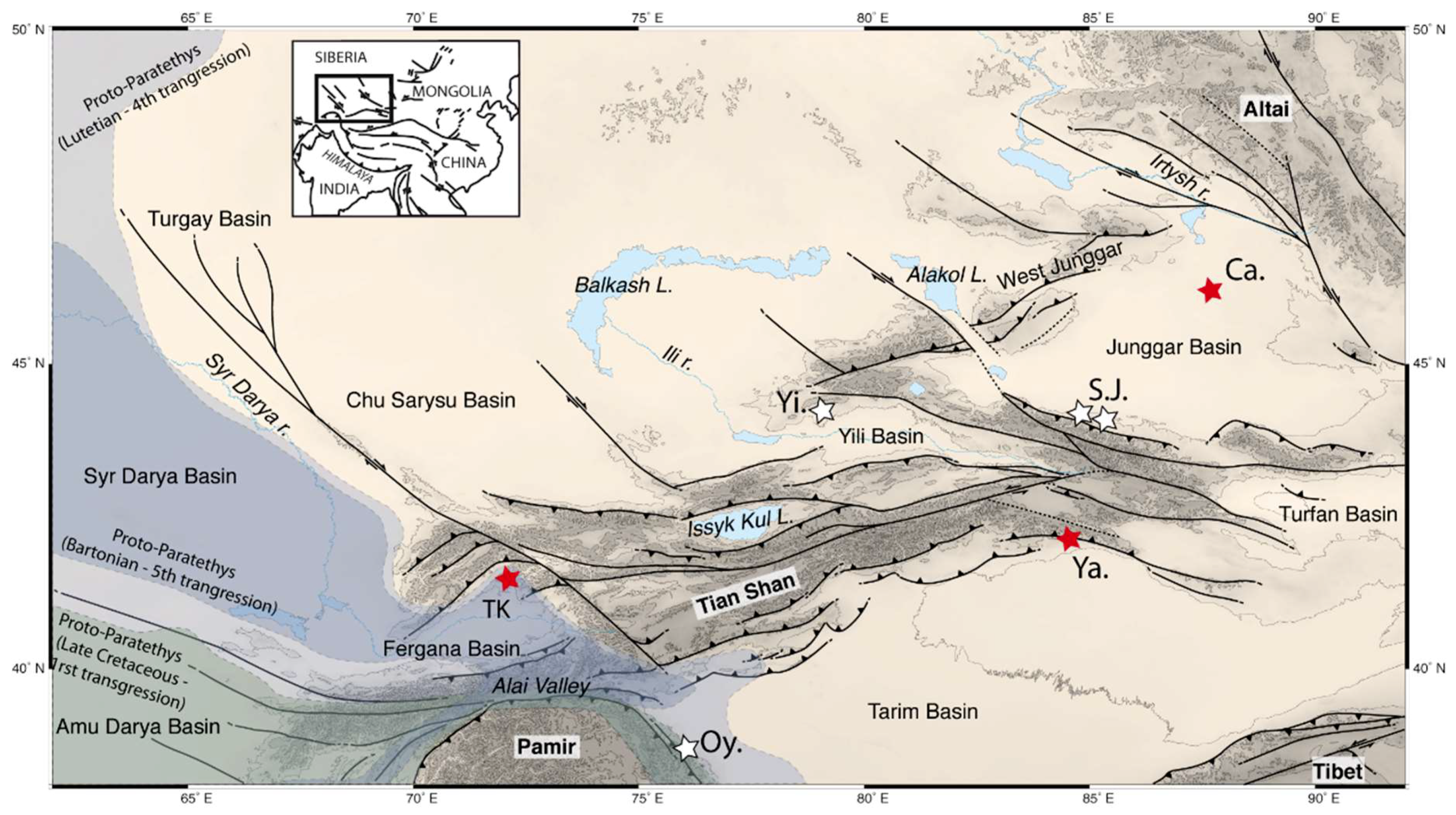
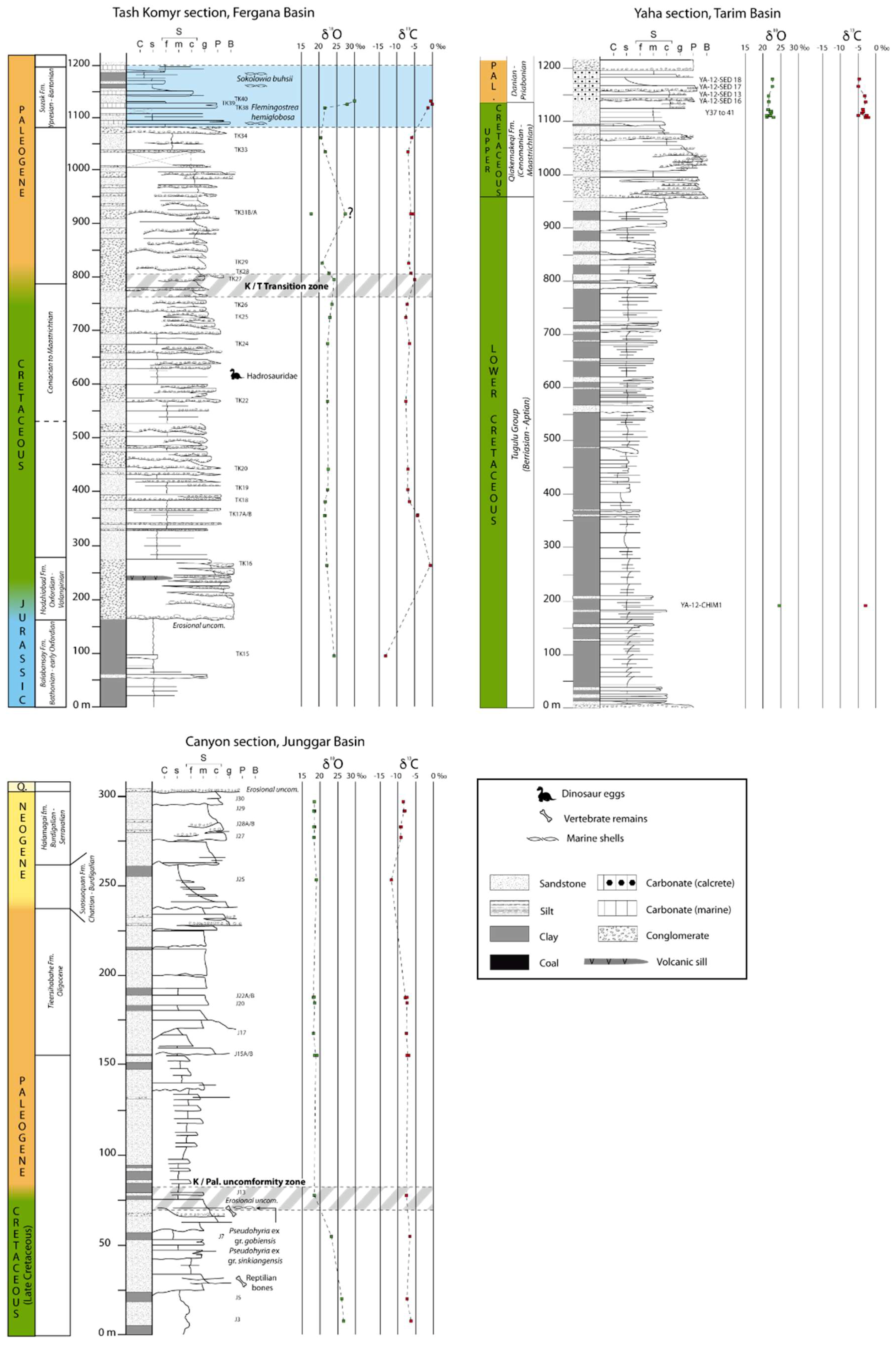
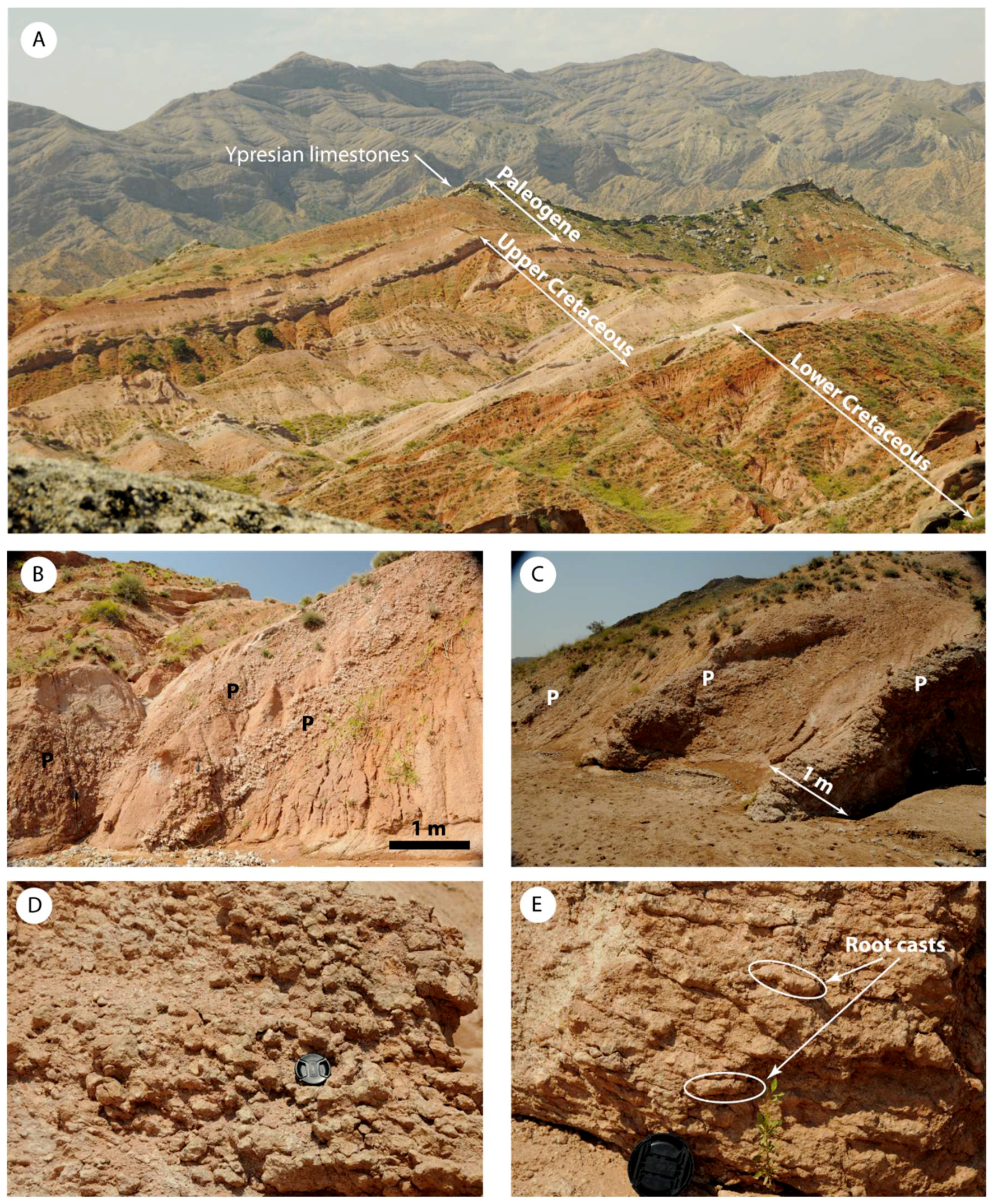
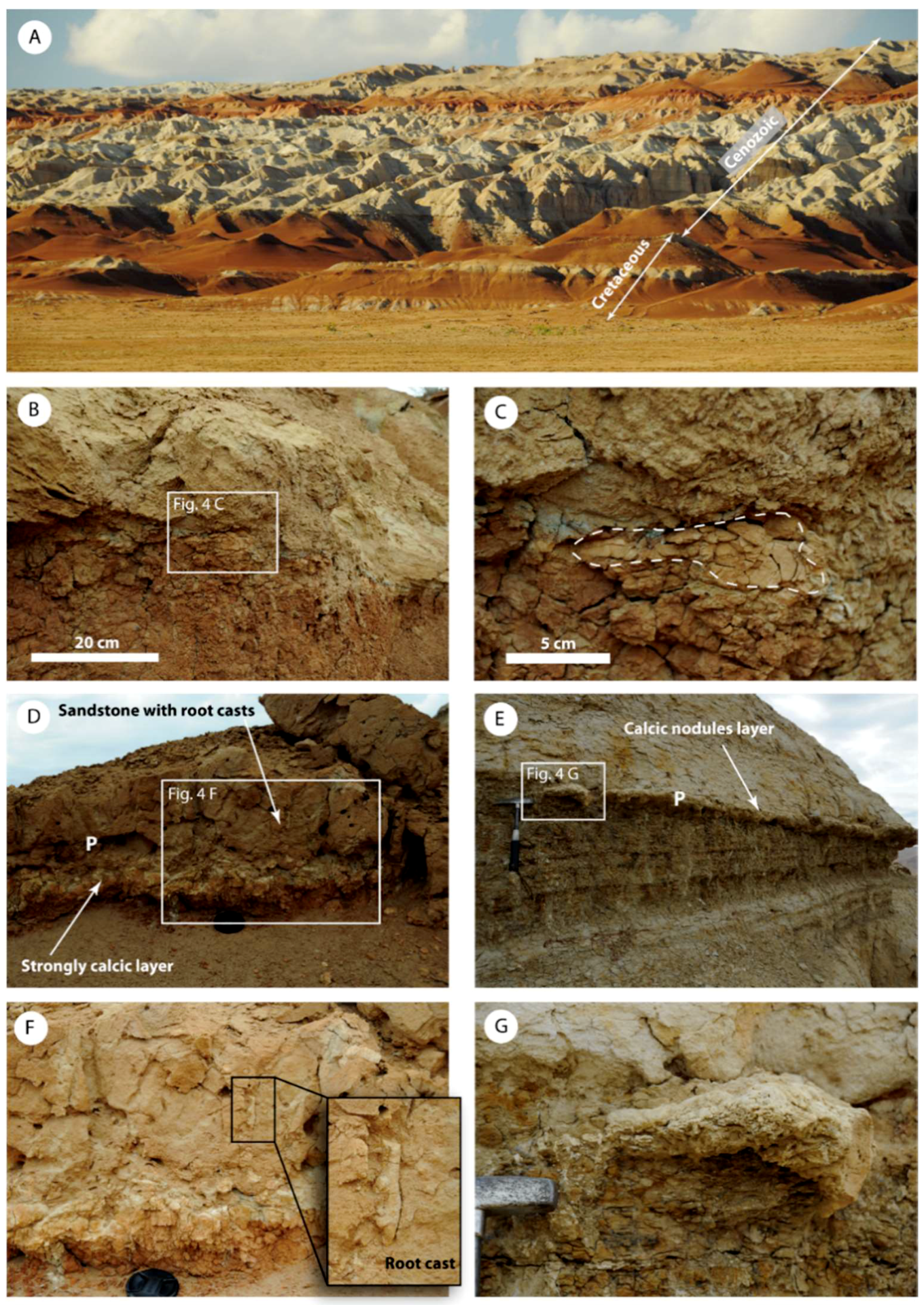
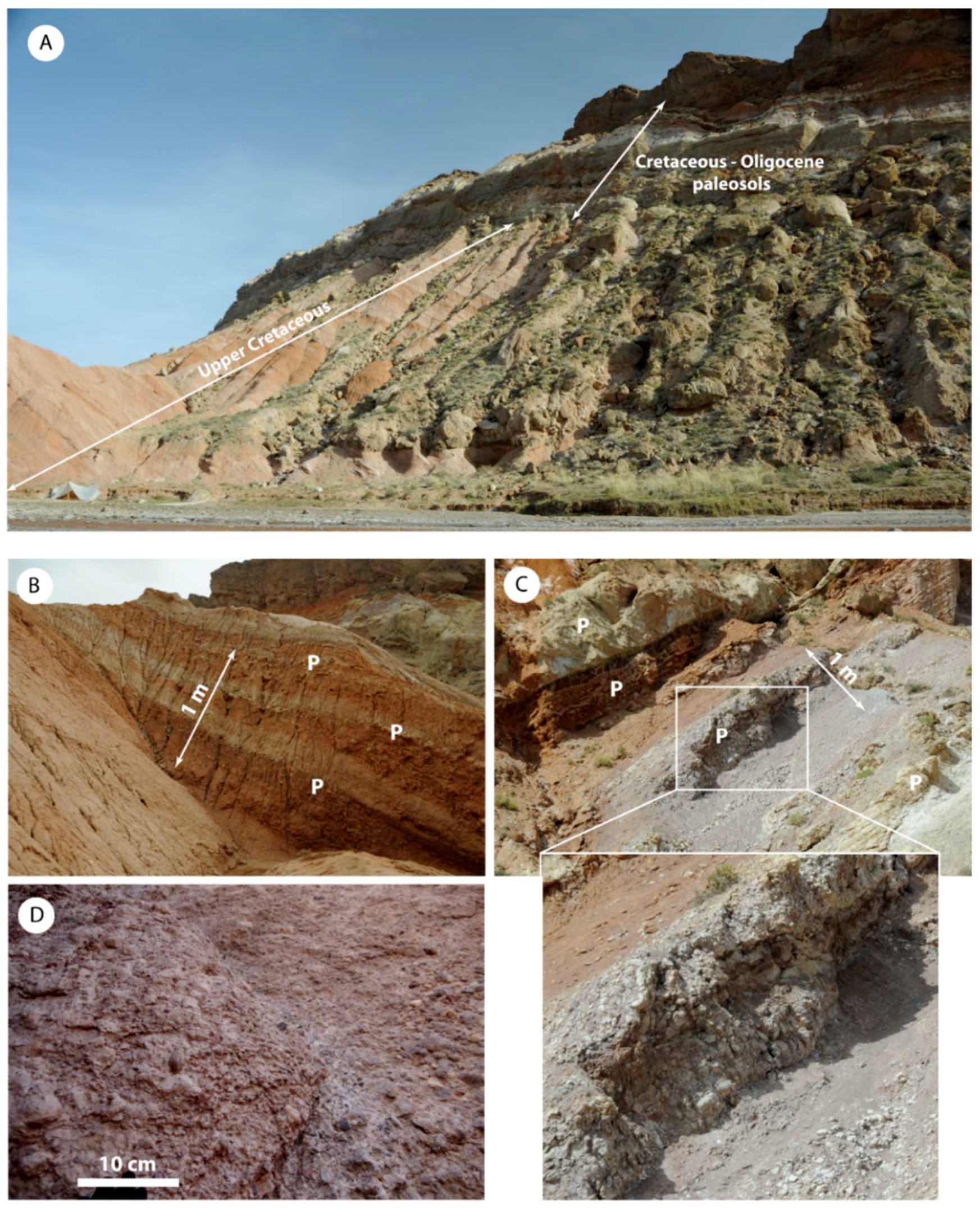
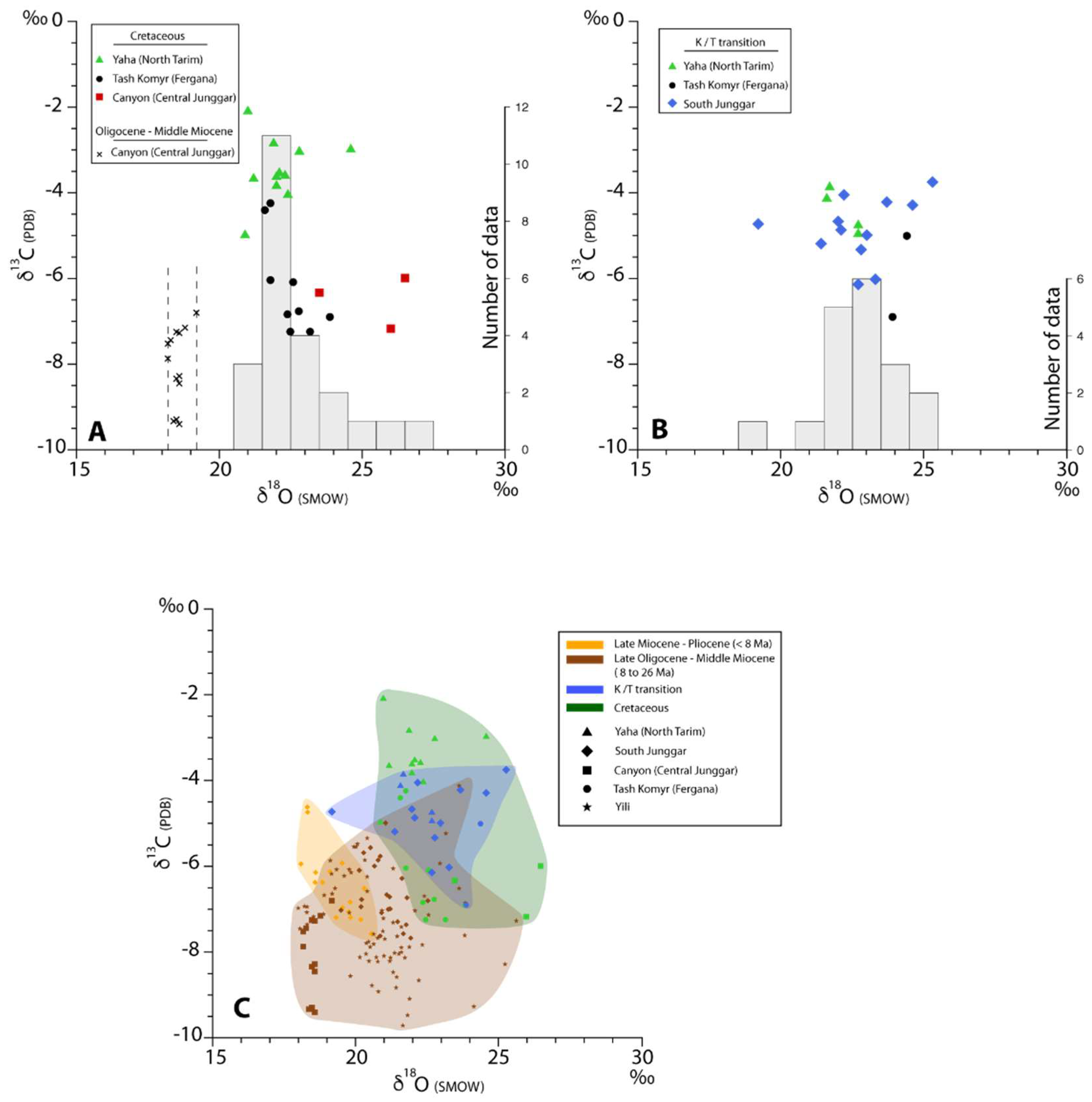
| Sample | Age | Type | δ18O (‰) | δ13C (‰) |
|---|---|---|---|---|
| Tash Komyr Section (Fergana Basin) | ||||
| TK15 | Barthonian-early Oxfordian | Nodule | 24.4 | −13.2 |
| TK16 | Oxfordian-Valanginian | Calcite coating on pebble | 22.3 | −0.4 |
| TK17A | Cretaceous | Calcite vein in caliche | 21.6 | −4.4 |
| TK17B | Cretaceous | Caliche | 21.8 | −4.2 |
| TK18 | Cretaceous | Caliche | 21.8 | −6.0 |
| TK19 | Cretaceous | Caliche | 22.4 | −6.8 |
| TK20 | Cretaceous | Caliche | 22.8 | −6.8 |
| TK22 | Coniacian-Maastrichtian | Caliche | 22.5 | −7.2 |
| TK24 | Coniacian-Maastrichtian | Caliche | 22.6 | −6.1 |
| TK25 | Coniacian-Maastrichtian | Calcite vein in caliche | 23.2 | −7.2 |
| TK26 | Coniacian-Maastrichtian | Caliche | 23.9 | −6.9 |
| TK27 | Cretaceous-Paleogene | Caliche | 24.4 | −5.0 |
| TK28 | Paleocene | Caliche | 23 | −5.9 |
| TK29 | Paleocene | Caliche | 20.8 | −6.4 |
| TK31A | Paleocene | Caliche | 27.2 | −5.2 |
| TK31B | Paleocene | Calcite vein in caliche | 17.9 | −5.8 |
| TK33 | Paleocene | Caliche | 21.8 | −6.5 |
| TK34 | Paleocene | Calcite vein in caliche | 20.3 | −5.7 |
| TK38 | Ypresian-Bartonian | Caliche | 21.8 | −1.0 |
| TK39 | Ypresian-Bartonian | Caliche | 28 | 0.1 |
| TK40 | Ypresian-Bartonian | Caliche | 30 | 0.4 |
| Canyon section (Junggar Basin) | ||||
| J3 | Late Cretaceous | Nodule | 26.5 | −6.0 |
| J5 | Late Cretaceous | Nodule | 26.0 | −7.2 |
| J7 | Late Cretaceous | Nodule | 23.5 | −6.3 |
| J13 | Paleogene | Caliche/Calcrete | 18.6 | −7.3 |
| J15A | Oligocene | Caliche/Calcrete | 19.2 | −6.8 |
| J15B | Oligocene | Calcite vein in caliche | 18.8 | −7.1 |
| J17 | Oligocene | Caliche/Calcrete | 18.2 | −7.5 |
| J20 | Oligocene | Caliche/Calcrete | 18.5 | −7.3 |
| J22A | Oligocene | Caliche | 18.2 | −7.9 |
| J22B | Oligocene | Caliche | 18.3 | −7.4 |
| J25 | Late Oligocene-Miocene | Caliche/Calcrete | 19.1 | −11.7 |
| J27 | Miocene | Calcite vein in caliche | 18.4 | −9.3 |
| J28A | Miocene | Caliche | 18.6 | −9.4 |
| J28B | Miocene | Calcite vein in caliche | 18.5 | −9.3 |
| J29 | Miocene | Caliche/Calcrete | 18.6 | −8.3 |
| J29 | Miocene | Caliche/Calcrete | 18.5 | −8.3 |
| J30 | Miocene | Caliche/Calcrete | 18.6 | −8.5 |
| Yaha section (North Tarim Basin) | ||||
| YA 12 SED 18 * | Cretaceous-Priabonian | Caliche | 22.7 | −4.8 |
| YA 12 SED 17 * | Cretaceous-Priabonian | Caliche | 22.7 | −5.0 |
| YA 12 SED 16 * | Cretaceous-Priabonian | Caliche | 21.7 | −3.9 |
| YA 12 SED 13 * | Cretaceous-Priabonian | Caliche | 21.6 | −4.1 |
| Y37A | Maastrichtian | Caliche | 22.8 | −3.0 |
| Y37B | Maastrichtian | Caliche | 21.0 | −2.1 |
| Y38A | Maastrichtian | Caliche | 22.0 | −3.8 |
| Y38B | Maastrichtian | Caliche | 22.1 | −3.5 |
| Y38C | Maastrichtian | Caliche | 20.9 | −5.0 |
| Y39 | Maastrichtian | Caliche | 22.4 | −4.0 |
| Y40A | Maastrichtian | Caliche | 22.3 | −3.6 |
| Y40B | Maastrichtian | Caliche | 22.0 | −3.6 |
| Y41 | Maastrichtian | Caliche | 21.2 | −3.7 |
| YA 12 CHIM 1 * | Lower Cretaceous | Nodule | 24.6 | −3.0 |
© 2018 by the authors. Licensee MDPI, Basel, Switzerland. This article is an open access article distributed under the terms and conditions of the Creative Commons Attribution (CC BY) license (http://creativecommons.org/licenses/by/4.0/).
Share and Cite
Jolivet, M.; Boulvais, P.; Barrier, L.; Robin, C.; Heilbronn, G.; Ledoyen, J.; Ventroux, Q.; Jia, Y.; Guo, Z.; Bataleva, E.A. Oxygen and Carbon Stable Isotope Composition of Cretaceous to Pliocene Calcareous Paleosols in the Tian Shan Region (Central Asia): Controlling Factors and Paleogeographic Implications. Geosciences 2018, 8, 330. https://doi.org/10.3390/geosciences8090330
Jolivet M, Boulvais P, Barrier L, Robin C, Heilbronn G, Ledoyen J, Ventroux Q, Jia Y, Guo Z, Bataleva EA. Oxygen and Carbon Stable Isotope Composition of Cretaceous to Pliocene Calcareous Paleosols in the Tian Shan Region (Central Asia): Controlling Factors and Paleogeographic Implications. Geosciences. 2018; 8(9):330. https://doi.org/10.3390/geosciences8090330
Chicago/Turabian StyleJolivet, Marc, Philippe Boulvais, Laurie Barrier, Cécile Robin, Gloria Heilbronn, Julie Ledoyen, Quentin Ventroux, Yingying Jia, Zhaojie Guo, and Elena A. Bataleva. 2018. "Oxygen and Carbon Stable Isotope Composition of Cretaceous to Pliocene Calcareous Paleosols in the Tian Shan Region (Central Asia): Controlling Factors and Paleogeographic Implications" Geosciences 8, no. 9: 330. https://doi.org/10.3390/geosciences8090330
APA StyleJolivet, M., Boulvais, P., Barrier, L., Robin, C., Heilbronn, G., Ledoyen, J., Ventroux, Q., Jia, Y., Guo, Z., & Bataleva, E. A. (2018). Oxygen and Carbon Stable Isotope Composition of Cretaceous to Pliocene Calcareous Paleosols in the Tian Shan Region (Central Asia): Controlling Factors and Paleogeographic Implications. Geosciences, 8(9), 330. https://doi.org/10.3390/geosciences8090330






